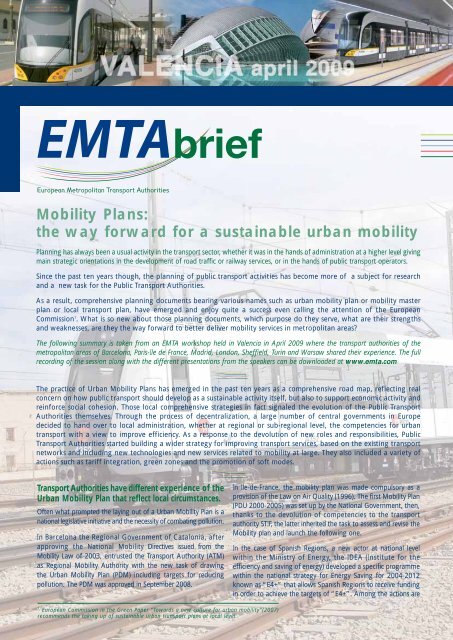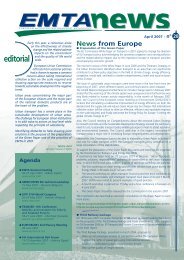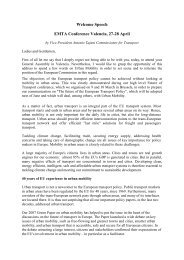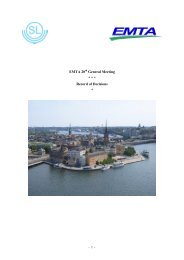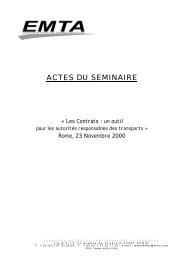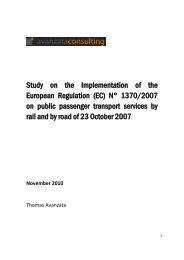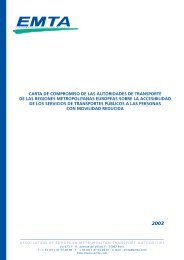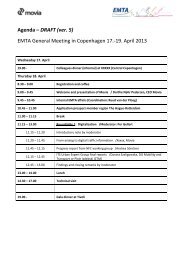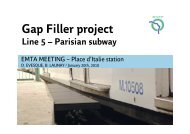Mobility Plans: the way forward for a sustainable urban ... - EMTA
Mobility Plans: the way forward for a sustainable urban ... - EMTA
Mobility Plans: the way forward for a sustainable urban ... - EMTA
You also want an ePaper? Increase the reach of your titles
YUMPU automatically turns print PDFs into web optimized ePapers that Google loves.
ief<br />
<strong>Mobility</strong> <strong>Plans</strong>:<br />
<strong>the</strong> <strong>way</strong> <strong><strong>for</strong>ward</strong> <strong>for</strong> a <strong>sustainable</strong> <strong>urban</strong> mobility<br />
Planning has al<strong>way</strong>s been a usual activity in <strong>the</strong> transport sector, whe<strong>the</strong>r it was in <strong>the</strong> hands of administration at a higher level giving<br />
main strategic orientations in <strong>the</strong> development of road traffic or rail<strong>way</strong> services, or in <strong>the</strong> hands of public transport operators.<br />
Since <strong>the</strong> past ten years though, <strong>the</strong> planning of public transport activities has become more of a subject <strong>for</strong> research<br />
and a new task <strong>for</strong> <strong>the</strong> Public Transport Authorities.<br />
As a result, comprehensive planning documents bearing various names such as <strong>urban</strong> mobility plan or mobility master<br />
plan or local transport plan, have emerged and enjoy quite a success even calling <strong>the</strong> attention of <strong>the</strong> European<br />
Commission 1 . What is so new about those planning documents, which purpose do <strong>the</strong>y serve, what are <strong>the</strong>ir strengths<br />
and weaknesses, are <strong>the</strong>y <strong>the</strong> <strong>way</strong> <strong><strong>for</strong>ward</strong> to better deliver mobility services in metropolitan areas?<br />
The following summary is taken from an <strong>EMTA</strong> workshop held in Valencia in April 2009 where <strong>the</strong> transport authorities of <strong>the</strong><br />
metropolitan areas of Barcelona, Paris-Ile de France, Madrid, London, Sheffield, Turin and Warsaw shared <strong>the</strong>ir experience. The full<br />
recording of <strong>the</strong> session along with <strong>the</strong> different presentations from <strong>the</strong> speakers can be downloaded at www.emta.com<br />
The practice of Urban <strong>Mobility</strong> <strong>Plans</strong> has emerged in <strong>the</strong> past ten years as a comprehensive road map, reflecting real<br />
concern on how public transport should develop as a <strong>sustainable</strong> activity itself, but also to support economic activity and<br />
rein<strong>for</strong>ce social cohesion. Those local comprehensive strategies in fact signaled <strong>the</strong> evolution of <strong>the</strong> Public Transport<br />
Authorities <strong>the</strong>mselves. Through <strong>the</strong> process of decentralization, a large number of central governments in Europe<br />
decided to hand over to local administration, whe<strong>the</strong>r at regional or sub-regional level, <strong>the</strong> competencies <strong>for</strong> <strong>urban</strong><br />
transport with a view to improve efficiency. As a response to <strong>the</strong> devolution of new roles and responsibilities, Public<br />
Transport Authorities started building a wider strategy <strong>for</strong> improving transport services, based on <strong>the</strong> existing transport<br />
networks and including new technologies and new services related to mobility at large. They also included a variety of<br />
actions such as tariff integration, green zones and <strong>the</strong> promotion of soft modes.<br />
Transport Authorities have different experience of <strong>the</strong><br />
Urban <strong>Mobility</strong> Plan that reflect local circumstances.<br />
Often what prompted <strong>the</strong> laying out of a Urban <strong>Mobility</strong> Plan is a<br />
national legislative initiative and <strong>the</strong> necessity of combating pollution.<br />
In Barcelona <strong>the</strong> Regional Government of Catalonia, after<br />
approving <strong>the</strong> National <strong>Mobility</strong> Directives issued from <strong>the</strong><br />
<strong>Mobility</strong> Law of 2003, entrusted <strong>the</strong> Transport Authority (ATM)<br />
as Regional <strong>Mobility</strong> Authority with <strong>the</strong> new task of drawing<br />
<strong>the</strong> Urban <strong>Mobility</strong> Plan (PDM) including targets <strong>for</strong> reducing<br />
pollution. The PDM was approved in September 2008.<br />
1 European Commission in <strong>the</strong> Green Paper “Towards a new culture <strong>for</strong> <strong>urban</strong> mobility”(2007)<br />
recommends <strong>the</strong> taking up of <strong>sustainable</strong> <strong>urban</strong> transport plans at local level.<br />
In Ile-de-France, <strong>the</strong> mobility plan was made compulsory as a<br />
provision of <strong>the</strong> Law on Air Quality (1996). The first <strong>Mobility</strong> Plan<br />
(PDU 2000-2005) was set up by <strong>the</strong> National Government, <strong>the</strong>n,<br />
thanks to <strong>the</strong> devolution of competencies to <strong>the</strong> transport<br />
authority STIF, <strong>the</strong> latter inherited <strong>the</strong> task to assess and revise <strong>the</strong><br />
<strong>Mobility</strong> plan and launch <strong>the</strong> following one.<br />
In <strong>the</strong> case of Spanish Regions, a new actor at national level<br />
within <strong>the</strong> Ministry of Energy, <strong>the</strong> IDEA (Institute <strong>for</strong> <strong>the</strong><br />
efficiency and saving of energy) developed a specific programme<br />
within <strong>the</strong> national strategy <strong>for</strong> Energy Saving <strong>for</strong> 2004-2012<br />
known as “E4+” that allows Spanish Regions to receive funding<br />
in order to achieve <strong>the</strong> targets of “E4+”. Among <strong>the</strong> actions are
transport measures and notably Urban<br />
<strong>Mobility</strong> <strong>Plans</strong>, mobility plans <strong>for</strong> trips to<br />
work (work travel plans) and <strong>the</strong> development<br />
of public transport by road. The Transport<br />
Authority CRTM is responsible <strong>for</strong> <strong>the</strong><br />
implementation of those plans.<br />
As of Warsaw it all started with <strong>the</strong> first<br />
transport policy document in 1995, <strong>the</strong>n<br />
completed with a Strategic Vision <strong>for</strong> <strong>the</strong><br />
development of <strong>the</strong> city towards 2020<br />
drafted by <strong>the</strong> City of Warsaw. In <strong>the</strong><br />
years 2007-2009, a new Strategy <strong>for</strong><br />
Sustainable Transport Development was<br />
drawn as a continuation of <strong>the</strong> above<br />
documents. The main point of <strong>the</strong> strategy<br />
is <strong>the</strong> <strong>sustainable</strong> transport development<br />
plan which unfolds into 2 goals. One is <strong>the</strong><br />
settlement of a metropolitan Transport<br />
Authority, in cooperation with <strong>the</strong> regional<br />
government, covering <strong>the</strong> main city and<br />
<strong>the</strong> surrounding municipalities 2 .<br />
The second is <strong>the</strong> modernization of <strong>the</strong><br />
transport system taking all modes simultaneously<br />
into account, with a view<br />
to upgrade (tram network), to extend<br />
(building of 2 metro line), to replace and<br />
“green” <strong>the</strong> vehicle fleets, to improve bus<br />
route conditions, and to achieve integration<br />
of fares and of sub-systems in a comprehensive<br />
<strong>way</strong> (eg integrate <strong>the</strong> sub<strong>urban</strong><br />
train services into <strong>the</strong> <strong>urban</strong> transport<br />
network). Warsaw working on <strong>the</strong> wider<br />
scope of Urban <strong>Mobility</strong>, adds measures<br />
concerning road safety, walking and cycling<br />
policies and contemplates <strong>the</strong> possibility of<br />
a road charging scheme but only after <strong>the</strong><br />
transport system has been improved.<br />
In Torino <strong>the</strong> situation was a preexisting<br />
overlapping of different levels of planning<br />
(from region, province and municipality)<br />
and a real expertise of <strong>the</strong> <strong>urban</strong> transport<br />
operator <strong>for</strong> <strong>the</strong> transport planning. The<br />
2 A draft-law is <strong>for</strong>eseen end of 2009.<br />
planning of transport services was handed<br />
onto <strong>the</strong> transport authority AMMT when<br />
created in 2003 by law. Interestingly <strong>the</strong><br />
scope is at once a metropolitan one<br />
(Torino city plus surroundings) and covers<br />
public and private transport modes.<br />
AMMT is also bound by <strong>the</strong> law to write<br />
<strong>the</strong> <strong>Mobility</strong> Plan. It started planning in<br />
2005 with a mobility and transport<br />
development plan that encompassed road<br />
traffic, Public Transport network, environmental<br />
impacts with appropriate assessments,<br />
<strong>the</strong>n articulated <strong>the</strong> document with o<strong>the</strong>r<br />
planning documents on rail<strong>way</strong> services<br />
and tariff integration.<br />
The context of Sheffield metropolitan area<br />
is <strong>the</strong> following: Public Transport Authorities<br />
PTAs have according to <strong>the</strong> law of 2000,<br />
to deliver along with 4 o<strong>the</strong>r partners<br />
(from high<strong>way</strong>, parking and land-planning<br />
administrations) <strong>the</strong> Local Transport Plan<br />
(LTP) that must be approved by regional<br />
partners <strong>the</strong>n given permission and funded<br />
by national government.<br />
The reason was first to pass down national<br />
funding of city regions to local areas <strong>for</strong><br />
implementing <strong>the</strong> LTP measures and<br />
second to contribute to <strong>the</strong> fulfillment of<br />
national targets about <strong>the</strong> air quality. First<br />
generation 2001-2006 of LTP was assorted<br />
with bonus mechanisms of “reward<br />
funding” which where felt incentive but<br />
disappeared with <strong>the</strong> second generation.<br />
All <strong>the</strong>se <strong>Mobility</strong> <strong>Plans</strong> somehow<br />
refer to a wider national strategy and<br />
not only do <strong>the</strong>y have to be compatible<br />
with national targets but <strong>the</strong>y even<br />
become an important tool at local<br />
level to fulfill <strong>the</strong> national ef<strong>for</strong>t<br />
in combating climate change and<br />
supporting economic and social<br />
challenges. ATM Barcelona also sees <strong>the</strong><br />
PDM as a tool to rationalize and consolidate<br />
various pre-existing separate<br />
sectoral plans. VBB Berlin-Brandenburg<br />
adds <strong>the</strong>se plans are very efficient tools<br />
that hold <strong>the</strong> whole transport strategies<br />
toge<strong>the</strong>r.<br />
<strong>Mobility</strong> plans are comprehensive documents.<br />
They cover main areas such as <strong>the</strong><br />
management and monitoring of regional<br />
mobility, <strong>the</strong> promotion of collective public<br />
transport and <strong>the</strong> enhancement of soft<br />
modes (walking and cycling) with a view<br />
to influence modal shift from private car to<br />
collective or non motorized means, <strong>the</strong><br />
transport and distribution of goods, and to<br />
a certain extent <strong>the</strong> planning of road<br />
traffic and <strong>the</strong> organization of parking<br />
(London, Barcelona, Torino). Targets are<br />
precise which relate to environment, to<br />
expected modal share, to noise. Guidelines<br />
are issued (in Barcelona and Madrid) to<br />
facilitate implementation of measures by<br />
local actors and in particular municipalities.<br />
And lastly, sets of indicators are elaborated<br />
to monitor progress and assess <strong>the</strong> results,<br />
<strong>for</strong> <strong>the</strong> emphasis must be put on delivery<br />
as Sheffield stresses, detailing <strong>the</strong> three<br />
axes of evaluation in <strong>the</strong> LTPs: about <strong>the</strong><br />
delivery of <strong>the</strong> announced scheme, about
2000<br />
2000<br />
2001<br />
2002<br />
2003<br />
2004<br />
2005<br />
2006<br />
2007<br />
2008<br />
2009<br />
2010<br />
2011<br />
2012<br />
Agenzia per la<br />
Mobilità metropolitana<br />
TO + 31 Municipalities<br />
“Strong network” 2012<br />
IMQ<br />
Metropolitan<br />
2010 <strong>Mobility</strong> Plan<br />
PMM<br />
Agenzia gets<br />
competence on metro<br />
TP Company<br />
GTT <strong>for</strong>mer ATM<br />
Bus Tram Metro<br />
IMQ<br />
2000<br />
5T Project<br />
5T Private/Public<br />
Company<br />
<strong>the</strong> related spending of money and finally<br />
about how in fulfilling <strong>the</strong> first two axes,<br />
are <strong>the</strong> indicators on a trend basis positively<br />
affected.<br />
The <strong>Mobility</strong> <strong>Plans</strong> have developed in a<br />
positive <strong>way</strong> and numerous implemented<br />
actions are successful. Work travel plans,<br />
strongly emphasized in Madrid by <strong>way</strong> of<br />
a specific network of T-lines (T standing <strong>for</strong><br />
trabajo, spanish <strong>for</strong> work) put in place to<br />
rein<strong>for</strong>ce <strong>the</strong> provision of service at<br />
peak hours is an example of flexibility and<br />
efficient answer on <strong>the</strong> part of <strong>the</strong><br />
Transport Authority.<br />
The process of adopting a <strong>Mobility</strong><br />
<strong>Plans</strong> is described in similar <strong>way</strong>s by<br />
<strong>the</strong> transport authorities. There is<br />
al<strong>way</strong>s a consultation phase which is<br />
emphasized everywhere. Transport<br />
Authorities such as ATM in Barcelona have<br />
a specific Consultation Council, AMMT<br />
Torino opted <strong>for</strong> a specific board of<br />
technicians from all administrative levels<br />
(Region, province and city) to join-up<br />
different expertise. In Ile-de-France at STIF<br />
a technical council sits alongside <strong>the</strong><br />
strategic council. Even if specific councils<br />
exist <strong>the</strong>re is a second step, which is that<br />
of consulting with <strong>the</strong> population. This<br />
phase, although time consuming (in <strong>the</strong><br />
City of<br />
Torino<br />
General Plan of<br />
Urb.Trafic PGTU<br />
IMQ<br />
2002<br />
Urban Trafic<br />
Plan PUT<br />
Birth of Agenzia<br />
PT development<br />
Strategy<br />
IMQ <strong>Mobility</strong> & PT develop.<br />
Start of Planning<br />
activities<br />
2004 (1st metro line eval.tn)<br />
<strong>Mobility</strong> & Transport development<br />
(2nd metro line evaluation)<br />
SFM devel-<br />
IMQ opment<br />
2006<br />
Urb. PT Up-<br />
2007-9 -> grade Plan<br />
PT Plan<br />
Tariff Integ-<br />
5T Public Company<br />
IMQ ration devel.<br />
2008 Rail<strong>way</strong> node<br />
Urban <strong>Mobility</strong><br />
evaluation<br />
Plan PUMS<br />
Start of SFM<br />
operation<br />
Development<br />
perspectives<br />
Province<br />
of Torino<br />
315 Municipalities<br />
2007-9<br />
PT Program<br />
Province<br />
Strategic Plan<br />
Region<br />
Piemonte<br />
8 Proninces<br />
Regional<br />
Transp. Plan<br />
Agenzia was<br />
established by<br />
law<br />
Regional<br />
Transp. Plan<br />
2007-9<br />
PT Program<br />
ITS & electron.<br />
ticketing @<br />
regional scale<br />
Agreement<br />
with Govern. Govern<br />
<strong>for</strong> funding<br />
case of Ile de France not only debates are<br />
organized in municipalities around <strong>the</strong><br />
proposed <strong>Mobility</strong> Plan, but a public<br />
enquiry is mandatory by law), is seen by<br />
Warsaw ZTM as very enlightening, many<br />
good ideas emerge that are taken into<br />
account. But most of all, STIF says, it is an<br />
important step to raise population interest<br />
and hopefully help implementing measures.<br />
Never<strong>the</strong>less, after this long process is<br />
over, <strong>the</strong> final decision belongs to <strong>the</strong><br />
Board of <strong>the</strong> Transport Authority.<br />
<strong>Mobility</strong> <strong>Plans</strong> though aren’t an easy<br />
path to go.<br />
<strong>Mobility</strong> <strong>Plans</strong> are cross-sectors documents,<br />
<strong>the</strong>y <strong>the</strong>re<strong>for</strong>e call <strong>for</strong> a new<br />
mindset among <strong>the</strong> technicians and<br />
training is needed <strong>for</strong> administrative<br />
entities coming from different technical<br />
culture to share and collaborate<br />
(AMMT Torino, SP Vilnius). The process of<br />
implementing measures can be slowed<br />
down or even only partially achieved by<br />
<strong>the</strong> diversity of actors acting at different<br />
administrative level. STIF Ile-de-France<br />
gives <strong>the</strong> example of road traffic measures<br />
which responsibilities are split between <strong>the</strong><br />
regional, <strong>the</strong> sub-regional and <strong>the</strong> local<br />
level making it difficult to know who is in<br />
charge of what.<br />
Beyond <strong>the</strong> classical transport network,<br />
additional aspects of mobility such as<br />
demand management of work travel plans,<br />
car-sharing, public bike-renting, even<br />
walking, are to be taken into account in<br />
<strong>the</strong> <strong>Mobility</strong> <strong>Plans</strong>.<br />
New aspects of <strong>urban</strong> mobility combined<br />
with <strong>the</strong> recent devolution of responsibilities<br />
at local level, result in an<br />
increasing need <strong>for</strong> expertise and training.<br />
Transport authorities have to acquire new<br />
skills to cope with emerging needs of<br />
mobility reckons AMT Barcelona, while <strong>the</strong><br />
recently settled AMMT Torino thinks that<br />
expertise is still <strong>for</strong> a large part with <strong>the</strong><br />
operator of public transport in <strong>the</strong> city of<br />
Torino. Not least important is <strong>the</strong> transfer<br />
of expertise to municipal level. CRTM<br />
Madrid and Stadsregio Amsterdam have<br />
pointed out that in <strong>the</strong> metropolitan area,<br />
expertise is more likely to be found in <strong>the</strong><br />
main city ra<strong>the</strong>r that in smaller municipalities<br />
where actually many of <strong>the</strong> measures<br />
will have to be implemented.<br />
<strong>Mobility</strong> <strong>Plans</strong>, because <strong>the</strong>y embrace<br />
<strong>the</strong> wider scope of reducing congestion,<br />
and supporting economic growth and<br />
social inclusion, are linked to o<strong>the</strong>r<br />
planning policies and documents are<br />
deemed to interact nicely. Actually it is<br />
not al<strong>way</strong>s <strong>the</strong> case. Sheffield recalls<br />
that in <strong>the</strong> first generation of LTPs (2001-<br />
2006) such links with land use planning<br />
were assumed to happen but not al<strong>way</strong>s<br />
did, a five years period of time is too short.<br />
Besides <strong>the</strong> planning activities are still kept<br />
running in parallel in <strong>the</strong> different administrations<br />
even if <strong>the</strong>y acknowledge each<br />
o<strong>the</strong>r’s.<br />
One interesting question is how<br />
influential becomes a <strong>Mobility</strong> plan set<br />
up with various partners, when <strong>the</strong>y<br />
<strong>the</strong>mselves draw <strong>the</strong>ir own planning?<br />
It appears that when <strong>the</strong> partners are<br />
o<strong>the</strong>r sector of <strong>the</strong> administration, one can<br />
assume targets are more easily reconciled<br />
but when it comes to <strong>the</strong> private sector it<br />
is more difficult to ensure consistency in<br />
<strong>the</strong> long term and go against private<br />
initiative in a liberal context. The point of<br />
view is shared by Brussels and ZTM<br />
Warsaw. ATM Barcelona offers a <strong>way</strong> to<br />
solve <strong>the</strong> problem by making it mandatory<br />
by law that <strong>the</strong> Transport Authority is<br />
consulted about real estate projects and<br />
issues a favorable opinion, o<strong>the</strong>rwise <strong>the</strong><br />
project has to be stopped.<br />
Lessons learnt from experience by<br />
Transport Authorities are numerous<br />
Moving from a local to a metropolitan<br />
viewpoint is a slow process. On <strong>the</strong> o<strong>the</strong>r<br />
hand, as different local authorities join-up<br />
in <strong>the</strong> process of elaborating <strong>the</strong> <strong>Mobility</strong><br />
Plan, it becomes an opportunity <strong>for</strong> better
consistency in planning says AMMT Torino,<br />
which adds that municipalities enjoy <strong>the</strong><br />
process feeling that <strong>the</strong>y are better heard<br />
than in <strong>the</strong> previous planning process at<br />
higher level.<br />
The intricacy of inscribing <strong>the</strong> <strong>Mobility</strong><br />
<strong>Plans</strong> into a wider national planning<br />
frame, with same objectives but different<br />
selected targets or time frames,<br />
may generate constraints. Sheffield<br />
emphasizes that targets are chosen locally<br />
in <strong>the</strong> LTPs, however <strong>the</strong>y must contribute<br />
to national targets and sometimes all interests<br />
aren’t going in <strong>the</strong> same direction.<br />
Sheffield gives <strong>the</strong> example of Manchester<br />
where <strong>the</strong> LTP contemplated to setting a<br />
road charging in order to decrease congestion,<br />
but <strong>the</strong> local population didn’t agree<br />
to <strong>the</strong> proposition, so <strong>the</strong> Manchester LTP<br />
had to find ano<strong>the</strong>r <strong>way</strong> to reach <strong>the</strong> goal.<br />
In <strong>the</strong> same <strong>way</strong>, to reconcile national and<br />
local objectives, especially when local<br />
partners have different time-frame horizons<br />
can prove difficult. Sheffield gives <strong>the</strong><br />
example of suppliers of transport services<br />
which are private and operate on a oneyear<br />
basis, <strong>the</strong>y need to secure profit. This<br />
doesn’t fit very well into <strong>the</strong> three to five<br />
years planning of <strong>the</strong> LTPs.<br />
There is also <strong>the</strong> risk, says CENTRO from<br />
Birmingham, that various short term<br />
measures don’t add up necessarily in a<br />
consistent result in a longer term perspective.<br />
All <strong>the</strong> more it is difficult to deliver a major<br />
scheme within <strong>the</strong> five years range of an<br />
LTP, especially in case of problems of land<br />
use or economic crisis and <strong>the</strong>n little space<br />
is left to maneuver towards alternative<br />
schemes, stresses again Sheffield.<br />
Several Transport Authorities actually enjoy<br />
a high level of integrated competencies,<br />
beyond <strong>the</strong> pure public transport, to reach<br />
numerous aspects of mobility activity. TfL is<br />
a good example. As a matter of fact, a<br />
recent law passed in <strong>the</strong> UK (December<br />
2008) will result in <strong>the</strong> evolution of Public<br />
Transport Authorities into Integrated Transport<br />
Authorities extending competencies over<br />
high<strong>way</strong>s and freight management. When<br />
asked if this higher level of integration is<br />
<strong>the</strong> solution to get things work better, <strong>the</strong><br />
answer is that it certainly helps, but is not<br />
sufficient. Ano<strong>the</strong>r main point of <strong>Mobility</strong><br />
<strong>Plans</strong> is <strong>the</strong> delivery of measures and that<br />
happens at local level.<br />
This remark brings us to consider more<br />
closely <strong>the</strong> municipal level. Municipalities<br />
are crucial actors in achieving <strong>sustainable</strong><br />
mobility and in particular medium sized to<br />
small municipalities surrounding <strong>the</strong> main<br />
city. First of all, this is where <strong>the</strong> modal<br />
share of motorized trips goes as far as<br />
80% in favor of <strong>the</strong> private car (in Madrid<br />
metropolitan area <strong>for</strong> example) while<br />
length of trips are in <strong>the</strong>ir majority under 5<br />
to 7km. Typically a large part of those trips<br />
could be done by soft modes like cycling<br />
or walking and <strong>for</strong> <strong>the</strong> longest of <strong>the</strong>m<br />
by public transport. The real challenge to<br />
reverse <strong>the</strong> trends towards more <strong>sustainable</strong><br />
mobility lies with <strong>the</strong> medium size to small<br />
cities within <strong>the</strong> metropolitan area.<br />
Secondly <strong>the</strong>y often draw <strong>the</strong>ir <strong>Mobility</strong><br />
sub-<strong>Plans</strong> that have to be consistent with<br />
<strong>the</strong> regional document, hence <strong>the</strong> guidelines<br />
issued by <strong>the</strong> metropolitan Transport<br />
Authorities, as in Barcelona and Ile-de-France.<br />
Besides it is at local level that citizens give<br />
<strong>the</strong>ir comments through debates organized<br />
by <strong>the</strong> municipalities. There<strong>for</strong>e, as STIF Ile<br />
de France points out, <strong>the</strong>y need to be<br />
convinced of <strong>the</strong> relevance of specific<br />
measures and on <strong>the</strong> o<strong>the</strong>r hand,<br />
understand that <strong>the</strong>ir action will impact<br />
<strong>the</strong> <strong>Mobility</strong> Plan at regional level.<br />
Thirdly <strong>the</strong>y are <strong>the</strong> ones who implement<br />
<strong>the</strong> measures agreed upon. However <strong>the</strong>re<br />
is a need <strong>for</strong> expertise and training of<br />
technicians, <strong>for</strong> one part and <strong>the</strong>re is a<br />
need <strong>for</strong> money <strong>for</strong> <strong>the</strong> o<strong>the</strong>r part.<br />
Municipalities are “<strong>the</strong> end of <strong>the</strong> chain”,<br />
but <strong>the</strong>y shouldn’t be <strong>the</strong> weakest point.<br />
The Financial issue<br />
<strong>Mobility</strong> plans are mainly strategic documents,<br />
<strong>the</strong>y are not investment planning<br />
document, although among <strong>the</strong> measures<br />
agreed upon and depending on local<br />
circumstances, <strong>the</strong>y can include some<br />
investment schemes, usually not major<br />
ones. But again it depends on local<br />
circumstances. The case of Warsaw is<br />
somehow specific where <strong>the</strong> necessity to<br />
modernize and upgrade <strong>the</strong> whole<br />
transport system led to <strong>the</strong> laying out of<br />
major investment schemes like <strong>the</strong> building<br />
of metro line 2, aside <strong>the</strong> mobility plan,<br />
within <strong>the</strong> general strategy.
In <strong>the</strong> case of LTPs, in <strong>the</strong> United Kingdom,<br />
<strong>the</strong> major schemes (over 5 mio €) are<br />
funded by <strong>the</strong> central Government whereas<br />
<strong>the</strong> ongoing funding <strong>for</strong> providing services<br />
is funded by local tax paid <strong>for</strong> by <strong>the</strong><br />
citizens. But <strong>the</strong> problem arises says<br />
Sheffield when it comes to fund <strong>the</strong><br />
providing of services related to new<br />
infrastructures.<br />
Generally speaking, <strong>the</strong> financial issue of<br />
covering expanded services and higher<br />
level of quality resulting from ei<strong>the</strong>r <strong>the</strong><br />
recommended measures included in <strong>the</strong><br />
mobility plan or <strong>the</strong> simple increase of<br />
provision to respond to a higher demand<br />
encouraged by successful policy on modal<br />
shift, remains a problem. It seems al<strong>way</strong>s<br />
easier AMMT Torino adds, to fund an investment<br />
than to cover current operational costs.<br />
Sheffield recommends funding are<br />
secured on a long term basis (longer<br />
than five years) to ensure measures<br />
recommended are implemented and<br />
<strong>the</strong> whole system benefits. This in turn<br />
calls <strong>for</strong> <strong>the</strong> responsibility of <strong>the</strong> Transport<br />
Authority to demonstrate it delivers value<br />
<strong>for</strong> money.<br />
Then <strong>the</strong>re is <strong>the</strong> problem of <strong>the</strong> municipalities.<br />
They have to implement <strong>the</strong> measures<br />
and often to launch studies be<strong>for</strong>e hand.<br />
They not only lack <strong>the</strong> expertise, <strong>the</strong>y also<br />
lack <strong>the</strong> money. In Catalonia, municipalities<br />
contribute to a large extend to financing<br />
metropolitan mobility measures. Even in<br />
particular schemes like Spanish regions<br />
where <strong>the</strong> “E4+” programme provides <strong>for</strong><br />
60% of <strong>the</strong> funding, <strong>the</strong>re still remain<br />
40% to be covered by municipalities or by<br />
<strong>the</strong> Public Transport Authority as is <strong>the</strong><br />
case <strong>for</strong> Madrid. This proves very difficult<br />
in recession circumstances.<br />
The economic crisis has impacted <strong>the</strong><br />
public transport sector with more or less<br />
severeness according to local circumstances<br />
and thus <strong>the</strong> development of <strong>Mobility</strong><br />
<strong>Plans</strong>. The main worry is about<br />
covering <strong>the</strong> operational costs of <strong>the</strong><br />
whole system when public funds<br />
cannot be increased and fare revenues<br />
are on <strong>the</strong> decline due to a decreasing<br />
number of passengers. Responses from<br />
Transport authorities are diverse. TfL<br />
London reckons some smaller projects of<br />
<strong>the</strong> <strong>Mobility</strong> Transport Plan had to be<br />
postponed. But <strong>the</strong> fact that <strong>the</strong> plan<br />
enjoys a budget secured by <strong>the</strong> Central<br />
Government <strong>for</strong> ten years until 2017, and<br />
that will cover around 50% of <strong>the</strong> running<br />
costs while <strong>the</strong> o<strong>the</strong>r 50% come from <strong>the</strong><br />
fare box, even if passenger ridership has<br />
indeed decreased compared to 2007,<br />
should avoid TfL a major threat. In <strong>the</strong> case<br />
of CRTM Madrid some schemes had to be<br />
delayed or postponed, <strong>for</strong>tunately of<br />
smaller importance, <strong>for</strong> <strong>the</strong> main investment<br />
projects had already happened in <strong>the</strong> past<br />
12 years and <strong>the</strong> remaining schemes are<br />
related to buses, thus less costly. However<br />
CRTM Madrid is contemplating a reduction<br />
of transport services on <strong>the</strong> network in<br />
order to adjust to lower revenues, while<br />
ATM Barcelona thinks about turning to a<br />
loan to be able to maintain <strong>the</strong> same level<br />
of services considering it is a necessary<br />
support to economic recovery.<br />
What about attracting <strong>the</strong> private sector?<br />
Would it be a break-through?<br />
The experience of Transport Authorities<br />
with public-private-partnerships PPPs<br />
are ra<strong>the</strong>r good ones which tends to<br />
prove that <strong>the</strong>re is clearly a place <strong>for</strong><br />
<strong>the</strong> private sector in <strong>the</strong> field of<br />
mobility schemes. Several infrastructure<br />
projects have been or are currently<br />
successful whe<strong>the</strong>r in Madrid, Barcelona<br />
or London. When it comes to smaller<br />
schemes like a bike–rental or car-sharing,<br />
business models diverge and implementation<br />
is too recent to allow sound assessment.<br />
However <strong>the</strong>re is a fear that revenues based<br />
on advertising would not be as attractive<br />
nowadays <strong>for</strong> <strong>the</strong> private sector.<br />
Conclusions and recommendations<br />
There has been a long tradition of planning<br />
in <strong>the</strong> transport sector and <strong>Mobility</strong> <strong>Plans</strong><br />
reflect <strong>the</strong> expansion of this activity taking<br />
into account <strong>the</strong> new aspects of <strong>urban</strong><br />
mobility. The slow process of decentralization<br />
devolving more competencies to <strong>the</strong><br />
regional or sub regional level happened<br />
at a time when levels of pollution and<br />
environmental threats led central governments<br />
to take legal action and set targets<br />
to decrease <strong>the</strong> negative impacts in a wide<br />
range.<br />
The <strong>Mobility</strong> <strong>Plans</strong> have emerged as a<br />
local response to inacceptable levels<br />
of pollution and congestion, of unnecessary<br />
damaging consumption of<br />
energy and also as a response to <strong>the</strong><br />
economic and social inefficiency in <strong>the</strong><br />
dispersion of planning authorities<br />
each of <strong>the</strong>m running after its own<br />
goals.<br />
A higher integration of competencies<br />
within <strong>the</strong> Transport Authorities, covering<br />
public transport networks, tariff integration,<br />
road administration and parking<br />
policies and new aspects of <strong>urban</strong> mobility<br />
at large will certainly help. The challenge<br />
though lies more with <strong>the</strong> municipalities.<br />
<strong>Mobility</strong> <strong>Plans</strong> have regional objectives<br />
which must be locally delivered.<br />
Municipalities are places where strong<br />
collaboration with <strong>the</strong> Transport<br />
Authority is useful to stimulate a more<br />
pro-active acting; where <strong>the</strong> transfer<br />
of expertise should be cared <strong>for</strong> to<br />
help developing <strong>the</strong> feasibility studies;<br />
and where funding needed <strong>for</strong><br />
implementing measures is harder to<br />
find even if matched by regional funds.
Members<br />
as of<br />
1 rst may 2009<br />
Members 2009<br />
PTA City Population Web Site<br />
STADSREGIO AMSTERDAM 1,365,485 www.stadsregioamsterdam.nl<br />
ATM BARCELONA MoB* 4,857,000 www.atm.cat<br />
CMTBC BAHIA DE CADIZ 1,194,062 www.cmtbc.es<br />
in summer season 1,512,750<br />
VBB BERLIN-BRANDENBURG President 5,951,809 www.vbbonline.de<br />
CTB BILBAO 1,139,863 www.cotrabi.com<br />
CENTRO BIRMINGHAM 2,591,300 www.centro.org.uk<br />
MRBC BRUSSELS-CAPITALE<br />
REGION Treasurer 2,988,029 www.bruxelles.irisnet.be<br />
BKSZ Kht BUDAPEST MoB* 3,200,000 www.bksz.hu<br />
MOVIA COPENHAGUEN 1,831,751 www.movia.dk<br />
DTO DUBLIN 1,535,000 www.dto.ie<br />
RMV FRANKFURT 5,000,000 www.rmv.de<br />
HVV HAMBURG 3,320,000 www.hvv.de<br />
YTV HELSINKI 996,000 www.ytv.fi<br />
TfL LONDON 7,512,400 www.tfl.gov.uk<br />
SYTRAL LYON 1,373,300 www.sytral.fr<br />
CRTM MADRID Vice President 6,008,183 www.ctm-madrid.es<br />
GMPTE MANCHESTER 2,553,800 www.gmpte.com<br />
ATM MILAN 3,700,000 www.comune.milano.it<br />
AMT MONTREAL 3,596,000 www.amt.qc.ca<br />
RUTER OSLO 840,000 www.ruter.no<br />
STIF PARIS ILE-DE-FRANCE Vice President 11,491,000 www.stif.info<br />
ROPID PRAGUE 1,700,000 www.ropid.cz<br />
CTAS SEVILLA 1,250,597 www.consorciotransportes-sevilla.com<br />
SYPTE SHEFFIELD MoB* 1,292,900 www.sypte.co.uk<br />
SL STOCKHOLM 1,918,104 www.sl.se<br />
VRS STUTTGART 2,673,729 www.region-stuttgart.org<br />
AMMT TORINO MoB* 1,531,755 www.mtm.torino.it<br />
eTM VALENCIA 1,732,830 www.etmvalencia.es<br />
VOR VIENNA 2,403,724 www.vor.at<br />
MESP VILNIUS 848,008 www.vilniustransport.lt<br />
ZTM WARSAW MoB* 2,270,585 www.ztm.waw.at<br />
MoB* : Member of <strong>the</strong> Board<br />
AML LISBON Observer 2,760,700 www.aml.pt<br />
39 bis / 41, rue de Châteaudun � F-75009 Paris<br />
Tél. + 33 1 53 59 21 10 - Fax + 33 1 53 59 21 33<br />
www.emta.com � contact@emta.com<br />
Artwork: Yolande HUBERTY (yh. crea@wanadoo.fr)


